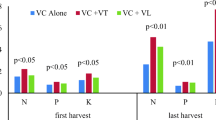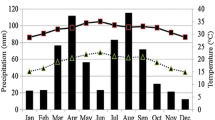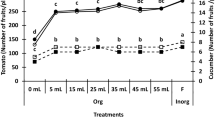Abstract
Tomato is the most widely grown vegetable in Africa. It goes into the preparation of many dishes, given its nutritional importance due to its content in active substances such as vitamins A and C, iron and phosphorus. Experiments were set up on a vegetable growing site at INRAN’s headquarters. This consisted in three trials with different treatments on tomato. Treated rice husk (150 g per plant) was used in the first trial and NPK (0, 2, 4, 6 g per pocket) in the second trial, whereas the third trial included the use of organic manure (1 kg of manure per bed), burned rice husk (1 kg per bed) and rock phosphate (2 g per pocket). Each trial was carried out in complete randomized block with three replicates. The results of these three trials show that the yield of 29 t ha−1 achieved with the application of treated rice husk (1.6 t.ha−1 rice husk 1.6 t ha−1, 1.6 t ha−1 sandy- soil +1.6 t ha−1 incubated manure for 14 days) per plant was higher compared to the yield of 25.6 t.ha−1 obtained by the application of a microdose of NPK (PP+ 6 g NPK per pocket or 187.5 kg ha−1) per plant. These first two treatments were more efficient than the combination of carbonized rice husk and organic manure (PP + NPK + BRC + PNT incubated for 14 days) per bed, with 22.4 t.ha−1. This clearly shows that the treatment with treated rice husk further improves the soil structure. This favors a good vegetative development and higher yields.
Access provided by CONRICYT-eBooks. Download chapter PDF
Similar content being viewed by others
Keywords
11.1 Introduction
In Niger, irrigated crops are growing exponentially as the climate is becoming increasingly unfavorable to rainfed agriculture (Saidou et al. 2013). The production of tomato Lycopersicum esculentum is an income generating activity for many farmers (Hanson et al. 2001). It is used in the preparation of most local foods due to its high contents in proteins and vitamins A and C.
The expansion of vegetable production only started in 1984, when the State officially started investing in the operation “Off-Season Crops”. The main objective is to alleviate cereal deficit in the country.
Generally, any increases in agricultural production can be achieved through improving soil fertility (Soltner 2000; Batiano et al. 2003). Tomato production, which does not escape the rule, increased from 57,685 t in 1996 to 112,445 t in 2000 and to 141,500 t in 2012 (RECA 2013). These increases were due to the use of organic and mineral fertilizers (RECA 2013).
In line with this, a study was carried out under the title: “Combined Effects of Organic and Mineral Fertilizers on Soil Productivity in Tomato Production: Experiments on soils of the Coast Road of Yantala-bas”.
The general objective of this work was to study the effects of different combinations of organic and mineral fertilizers on the growth and productivity of tomato on soils with low organic matter content. The specific objectives were:
-
To assess the effects of fertilization on tomato growth, early maturity and productivity;
-
To determine the optimal dose of NPK (15-15-15) for good tomato production.
11.2 Materials and Methods
11.2.1 Experimental Site
The experimental site was located on the Coast Road of Yantala-Bas between 13 ° 32′45.2 ′N and 2° 04′30.6′ ′E. The experiments were installed on a vegetable growing site at INRAN’s headquarters. Vegetable beds were made of solid materials at the nursery for the conservation and production of forest species of INRAN. In preparation for this study, the leached sand was replaced by sand taken from the Niger River. The River Niger water was used for watering.
The tomato variety Tropimech (commonly called Chaibo in Hausa and Kangaou in Zarma) was used.
Mineral fertilizers (NPK) and organic fertilizers were used.
11.2.2 Technical Equipment
Wheelbarrow, motor pump, hoe, watering can, caliper, graduated ruler, scales, GPS device, Arc-gis 12, Excel (2010), Statistix10.2.2.
11.2.3 Experimental Design and Treatments
The experimental design for the three trials consisted of randomized complete blocks.
The size of a vegetable bed was: width (75 cm) × length (150 cm), making an area of 1125 m2 each.
-
Trial 1: Effects of Incubation of the Various Treatments on Tomato Production it consisted of the following treatments:
-
1.
Control (T0)
-
2.
2.4 t ha−1 rice husk +2.4 t ha−1 loamy sandy soils (T1)
-
3.
2.3 t ha−1 rice husk +2.3 t ha−1 loamy sandy soils +170 kg ha−1 PNT (T2)
-
4.
2.4 t ha−1 carbonized rice husk +2.4 t ha−1 loamy sandy soils (T3)
-
5.
1.6 t ha−1 rice husk t ha−1 loamy sandy soils +1.6 t ha−1 manure (T4)
-
1.
-
Trial 2: Farmer Practice (FP) Combined with Different Rates of NPK on Tomato:
-
FP (1 kg of organic fertilizer per bed, or 9 t.ha−1 (T0)
-
FP + 6 g NPK/pocket (T1)
-
FP +4 g NPK/ pocket (T2)
-
FP +2 g NPK/pocket (T3)
-
-
Trial 3: Farmer Practice (FP) Combined with Tahoua Phosphate Rock (TPR) and Carbonized Rice Husk (CRH) on Tomato:
-
1.
Farmer practice (T0)
-
2.
FP + NPK + CRK+ TPR (T1)
-
3.
FP + NPK + CRH (T2)
-
4.
FP + NPK + TPR (T3)
-
5.
NB: FP: 1 kg of organic fertilizer per bed (9 t.ha −1 ); TPR : 2 g per pocket (62.5 kg.ha −1 ); NPK: 2 g per pocket (62.5 kg.ha −1 ); CRH: 1 kg per bed (9 t.ha −1 )
-
1.
11.3 Results and Discussion
11.3.1 Effects of Treatments on Growth and Yield Parameters
11.3.1.1 First Trial: Effects of Incubation of Various Treatments on Tomato Production Evolution of Growth and Yield Parameters
The growth (height and diameter) and yield (leaves, flowers, fruits) parameters evolve according to the treatments with different combinations of fertilizers. The following Table shows the effects of the first trial treatments on growth and yield parameters. The T4 treatment significantly increased the height, diameter, and number of leaves, flowers and fruits (Table 11.1). The sand from the Niger River bed does not contain plant nutrients but with the use of manure and rice husk, after a 2-week incubation period, a favorable effect was observed on tomato growing.
11.3.2 Yield Evolution Trial 1
The overall performance includes foliar and root development as well as tomato fruit production. The Fig. 11.1, 11.2 and 11.3 below shows the evolution of this overall performance.
Effects of treatments on yields (Trial 1)
NB: FW foliar weight, RW root weight, SFW Season fruits weight
T0: control; T1: 2.4 t ha−1 rice husk +2.4 t ha−1 sandy loamy soil; T2: 2.3 t ha−1 rice husk plus 2.3 t ha−1 sandy loamy soil plus 170 kg ha−1 TPR; T3: 2.4 t ha −1 carbonized rice husk +2.4 t ha −1 sandy loamy soils; T4: 1.6 t ha−1 rice husk +1.6 t ha−1 sandy loamy soil +1.6 t ha−1 manure
11.3.2.1 Trial 2: Farmer Practice (FP) Combined with Different Rates of NPK on Tomato
The growth parameters (height and diameter) and yield (leaves, flowers, fruits) vary according to the treatments with different combinations of fertilizers. T1 and T2 treatments did not significantly differ in terms of production of tomato fruits (Table 11.2).
11.3.2.2 Trial 3: Farmer Practice (FP) Combined with Tahoua Phosphate Rock (TPR) and Carbonized Rice Husk (CRH) on Tomato
11.3.2.2.1 Effects of Trial 3 Treatments on Growth and Yield Parameters (Table 11.3)
The T3 combination gave the most significant production of tomato fruits and this was consistent with all other growth parameters.
These values were lower than those obtained by Shankara et al. (2005), which showed that the height of indeterminate tomato plants ranged from 80 to 120 cm under natural growing conditions for 2 years. Regarding diameter, the results were in line with those obtained by Kotaix et al. (2013) in Côte d’Ivoire, which showed that diameter values ranged from 1.6 cm to 1.3 cm at the flowering stage.
These results relating to yield parameters (number of leaves, flowers, fruits) were the only ones recorded, since detailed analysis was not carried out in the framework of this study.
11.3.2.3 Trial 3 Effects of Trial 3 Treatments on Yields (Fig. 11.3)
The statistical analysis carried out on the yields obtained in Trial 1 showed that the performance of T4 treatment (29 t ha−1) was better compared to all other trials.
Results from the three trials were higher than that of the organic fertilizer treatment (Manure: 20 t.ha−1 of manure +50 kg of urea +50 kg of super-simple phosphate) which gave a yield of 20 t.ha −1 of tomato fruit (MDA 2009).
Some research works have shown that tomato yields can vary from 16 t.ha−1 to 30 t.ha−1 across the various treatments (Roy-Fortin et al. 2014).
11.3.3 Effects of Treatments on Early Maturity
Results of experiments on the dates of flowering and first harvest of tomato fruits (Table 11.4).
The results of the treatments showed very significant effects on the date of beginning of flowering (date when 50% of plants have flowered) and the date of the first harvest of tomato fruits for the three trials between the positive and negative controls, in the following sequential order: trial1, trial 3 and trial2, regarding early flowering and fruiting.
These were the earlier results compared to the flowering dates of 23 DAT on the sites under the rate of 5 l ha−1 and 25 DAT in Bimbresso and 24 DAT in Bouaflé under the rate of 3.75 l.ha−1 (Kotaix et al. 2013).
11.4 Conclusion
L’observation de la date de la floraison et de la fructification sur la précocité par les témoins positifs et négatifs montre l’utilité des traitements dans l’ordre de subséquence dont l’essai1 puis essai3 et essai2.
The study results have shown that T4 treatment under trial 1 increased the growth and yield parameters. In trial 2, the combinations T1 and T2 gave the best yields. In trial 3, T2 treatment gave the highest increase in tomato production. These various treatments should be recommended to tomato producers depending on the availability and accessibility of inputs in their production areas.
Observation of the dates of early flowering and fruiting on the positive and negative controls shows the efficiency of the various treatments in the following sequential order: trial1, trial3 and trial2.
In fact, the application of rice husk under micro-dose treatment allows better improvement of soil structure, which leads to a good vegetative development of the crop and a good production of tomato fruits. The 6 g NPK (15-15-15) is the optimal dose for good tomato production. This confirms the assumption of this study and the achievement of its objectives.
Lastly, to ensure integrated soil fertility management and optimal and sustainable use of the nutrient reserves of mineral fertilizers and organic amendments, tomato growers are recommended to:
-
Improve farmer practice with the use of rice husk;
-
Encourage the treatment of rice husk especially with organic fertilizers; and
-
Apply carbonized rice husk in incubation for at least 2 weeks.
References
Batiano, A., Mokwunye, U., Vlek, P. L. G., Kaola, S., & Shapiro, B. (2003). Soil Fertility Management for sustainable land use in the West African Sudano-Sahelian zone (253–286 p).
Guéro, Y., & Dan Lamso Nomaou (2006). Les projets de restauration des ressources naturelles et la fertilité des sols CRESA DE NIAMEY Etude sahélienne Mars (pp. 3–34).
Hanson, P., Chen, J. T. Kuo, C. G., Morris, R., & Open, R. T. (2001). Suggestions sur les pratiques culturales de la tomate. Learning Center.
Kotaix, J. A., Angui, P. T. K., Pierre, C. Z. K., Diby, N. L., Dao, D., & Bonfoh, B. (2013). Effet de l’engrais organique liquide «Dragon 1», sur le développement de la tomate Au Sud Et Au Centre-Ouest De La Côte D’ivoire (16 p).
MDA. (2009). Recueil des fiches techniques en gestion des ressources naturelles et de productions agro-sylvo-pastorales (270 p).
Réseau National Des Chambres D’Agriculture du Niger. (2013). Enquête sur les cultures maraichères (24 p).
Roy-Fortin, V., agr., A. Weill, agr., Ph.D. et J. Duval, agr., Ph.D., CETAB+. (2014). Optimisation de la fertilisation et essais de variétés pour la production de tomates en grands tunnels (8 p).
Saidou, A. K., Ichaou, A., & Habsatou, B. (2013). Test de complément minéral foliaire sur le riz au niveau de l’aménagement hydro-agricole de Saga et sur les cultures maraichères sur les sites de Gamkalé et Yantala corniche (18 p).
Shankara, N., Joep, V., Marja, G., Martin, H., & Barbara, V. (2005). La culture de tomate: Production, transformation et commercialisation. Agrodok, 17, 9–107.
Soltner, D. (2000). Les bases de la production végétale; Tome 1: Le sol et son amélioration Collection Sciences et Techniques Agricoles (472 p).
Author information
Authors and Affiliations
Corresponding author
Editor information
Editors and Affiliations
Rights and permissions
Copyright information
© 2018 Springer International Publishing AG, part of Springer Nature
About this chapter
Cite this chapter
Jamilou Salissou, I., Addam Kiari, S., Mahamane, S., Abdourhamane Toure, A., Hassane, B. (2018). Combined Effects of Organic and Mineral Fertilizers on Soil Productivity in Tomato Production: Experiments on Soils of the Coast Road of Yantala-Bas. In: Bationo, A., Ngaradoum, D., Youl, S., Lompo, F., Fening, J. (eds) Improving the Profitability, Sustainability and Efficiency of Nutrients Through Site Specific Fertilizer Recommendations in West Africa Agro-Ecosystems. Springer, Cham. https://doi.org/10.1007/978-3-319-58792-9_11
Download citation
DOI: https://doi.org/10.1007/978-3-319-58792-9_11
Published:
Publisher Name: Springer, Cham
Print ISBN: 978-3-319-58791-2
Online ISBN: 978-3-319-58792-9
eBook Packages: Biomedical and Life SciencesBiomedical and Life Sciences (R0)







